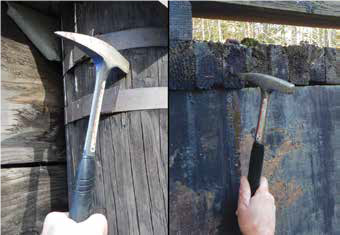Bridge - Hammer Sounding
Target of investigations
Hammer sounding is beneficial in identifying defects at a shallow depth from the wood surface. The technique is generally sensitive to defects at the severe stage .
Description
Hammer sounding, commonly used for inspecting wood structures, involves tapping the wood surface with an object, such as a hammer, and listening to the echo. Damaged areas typically have a hollow or dull sound, and their echo is different from those in the surrounding regions. Hammer sounding is more appropriate for inspecting small regions. For example, as soon as visual inspection identifies suspected areas of damage, hammer sounding can be used to further investigate the region.
Physical Principle
Hammer sounding is a vibration-based technique in which a hammer is used as an excitation source, and the inspector’s ears act as receivers. When an intact wood member is excited, its vibration frequency is related to its thickness and the velocity of sound in the member. For members with internal defects close to the surface, the vibration frequency is mainly affected by the vibration of the layer above the defects. Differences in the sound patterns caused by the vibration frequency of intact versus defective members enable an inspector to identify the defective regions.
Data Acquisition
For inspecting wood structures, a pick hammer, commonly used by geologists, is recommended.(1) The hammer allows for both sounding using the flat end and probing using the pick end. Hammer sounding is typically best used on side-grain, while pick probing can be used effectively at side- and end-grain locations. Once sounding detects potentially damaged or decayed areas, advanced inspection techniques, such as stress wave timing and resistance microdrilling, can be used for further investigations.

Figure 1. Photos. A pick hammer is used for sounding and probing wood members.(1)
Data Processing
No data processing is required
Data Interpretation
Areas with hollow or dull sounds are marked on the wood structure as defective regions.
Advantages
Hammer sounding includes the following advantages:
- Well-established field inspection technique.
- Quick and simple.
- Low cost.
Limitations
Some limitations of hammer sounding include the following:
- May fail to detect early or intermediate stages of decay.(2)
- Can be subjective.
- Does not provide quantitative information about the physical and mechanical properties of wood members.
References
- White, R. H., and R. J. Ross, eds. 2014. Wood and Timber Condition Assessment Manual. 2nd ed. General Technical Report No. FPL-GTR-234. Madison, WI: U.S. Department of Agriculture, Forest Service, Forest Products Laboratory.
- Ryan, T. W., J. E. Mann, Z. M. Chill, and B. T. Ott. 2012. FHWA Bridge Inspector’s Reference Manual (BIRM). Publication No. FHWA NHI 12-049. Washington, DC: Federal Highway Administration.




